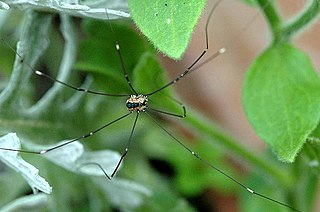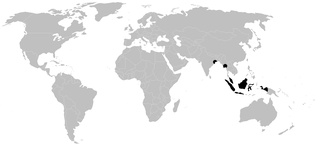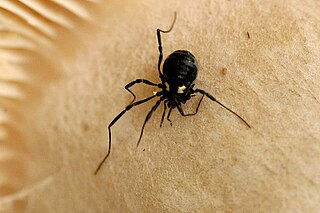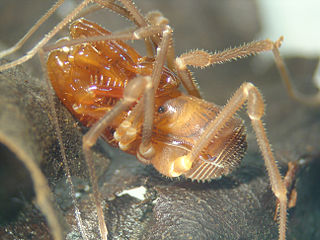Related Research Articles

The Opiliones are an order of arachnids colloquially known as harvestmen, harvesters, harvest spiders, or daddy longlegs. As of April 2017, over 6,650 species of harvestmen have been discovered worldwide, although the total number of extant species may exceed 10,000. The order Opiliones includes five suborders: Cyphophthalmi, Eupnoi, Dyspnoi, Laniatores, and Tetrophthalmi, which were named in 2014.
Bokokius is a monotypic genus of jumping spiders containing the single species, Bokokius penicillatus. It was first described by Carl Friedrich Roewer in 1942, and is only found on Bioko.

Cosmetidae is a family of harvestmen in the suborder Laniatores. With over 700 species, it is one of the largest families in Opiliones. They are endemic of the New World with a Nearctic-Neotropical distribution where a large fraction of the diversity of Opiliones are represented by this single family. Cosmetidae have the northern extent of their range into the USA, where a small number species occur in the southern states. However, the family is especially diverse in Mexico, Central America and northern South America; especially the Andean realms. Their range also extends further south into Argentina and southern Brazil, but they are absent in Chile. Cosmetidae are prevalent in Amazonian region, but only relatively few also occur in Brazilian Atlantic Forest. Several species are also found in the Caribbean.

The Sclerosomatidae are a family of harvestmen with about 1,300 known species. One former subfamily has been recently removed to form a new family, Globipedidae.

Leiobunum is a genus of the harvestman family Sclerosomatidae with more than 100 described species. Contrary to popular belief, they are not spiders, although they share a resemblance. They are arachnids, in the order Opiliones, harvestmen. Species in Leiobunum tend to have relatively long legs compared with other harvestmen, and some species are gregarious.

Sabaconidae is a family of harvestmen with 57 described species in one genus, Sabacon, which is found throughout the Northern Hemisphere.

The Stylocellidae are a family of harvestmen with about 30 described species, all of which occur from India to New Guinea. Members of this family are from one to seven millimeters long. While Stylocellus species have eyes, these are absent in the other two genera.

The Nemastomatidae are a family of harvestmen with about 170 described species in 16 recent genera. Several fossil species and genera are known.

Epedanidae is a family of the harvestman infraorder Grassatores with about 200 described species. They are the sister group of the Gonyleptoidea.

Assamiidae are a family of harvestmen with more than 400 described species. It is the third most diverse family of the suborder Laniatores.
The Stygnopsidae are a small family of harvestmen, with almost all species found in Mexico.

Stygnommatidae is a small neotropical family of the harvestman infraorder Grassatores with about thirty described species.

Podoctidae is a family of the harvestman infraorder Grassatores with about 130 described species.
Zalmoxis is a genus of harvestmen, within the Zalmoxidae family. They are found in tropical Australia, Borneo, New Guinea, the Philippines and on Pacific islands.
Cassinia macrochelis is a species of harvestman known from Guinea-Bissau.

Metaphalangium cirtanum is a species of harvestman belonging to the family Phalangiidae.

Anoteropsis hilaris, commonly referred as the garden wolf spider or the grey wolf spider, is a species of wolf spider that is endemic to New Zealand.
Barrussus is a genus of karschiid camel spiders, first described by Carl Friedrich Roewer in 1928.
References
- ↑ Roewer, C.F. (1935a) Alte und neue Assamiidae. Weitere Weberknechte VIII (8. Ergänzung der "Weberknechte der Erde" 1923). Veröffentlichungen aus dem Deutschen Kolonial- und Übersee-Museum in Bremen, Bremen, 1(1), 1–168.
- ↑ Roewer, C.F. (1923) Die Weberknechte der Erde. Systematische Bearbeitung der bisher bekannten Opiliones. Gustav Fischer, Jena, 1116 pp.
- ↑ Ponting, J. (2015) Replacement name for Euwintonius insulanus Suzuki, 1982 (Opiliones: Laniatores: Assamiidae: Dampetrinae), primary junior homonym of E. insulanus Roewer, 1940. Zootaxa. 3925(3):450